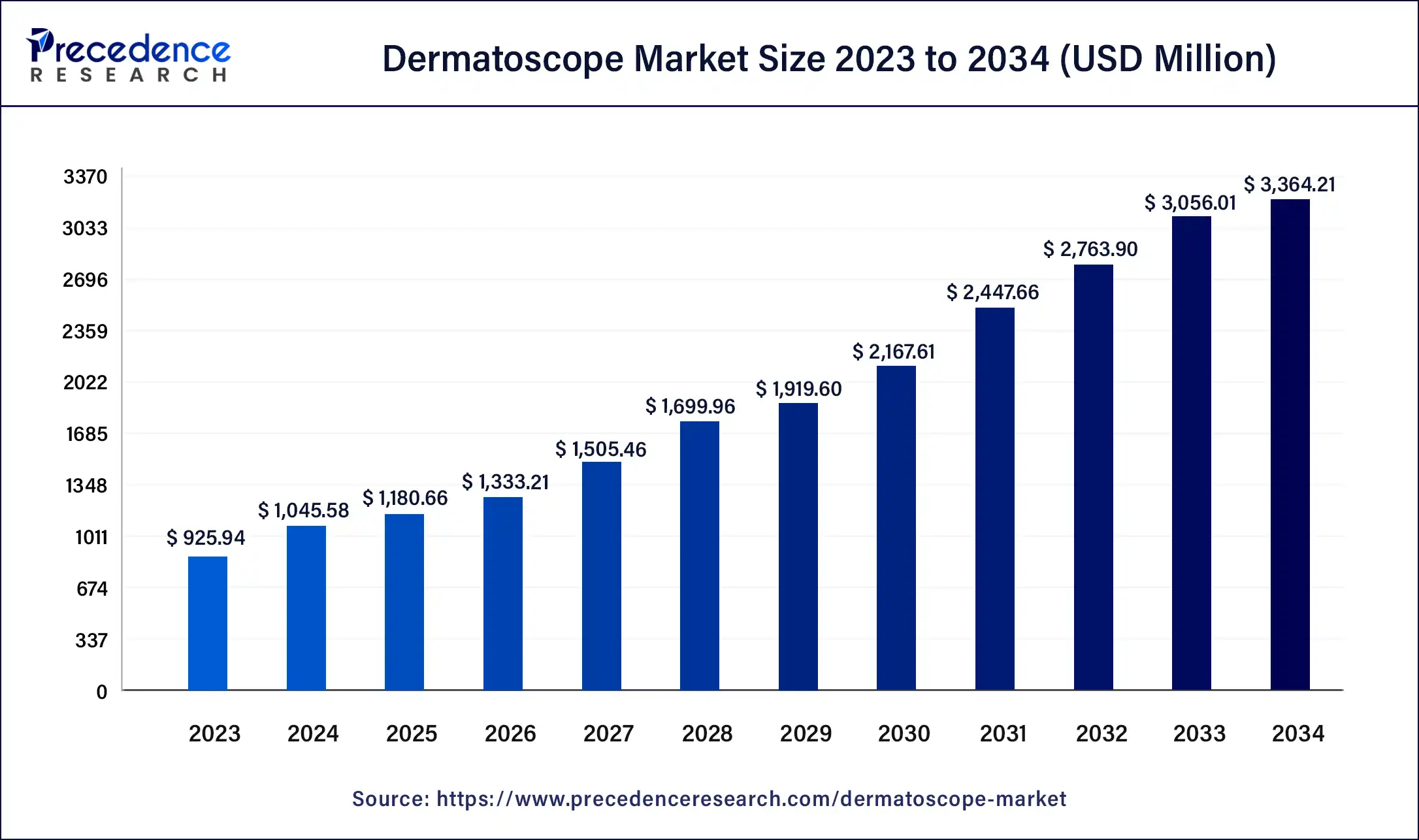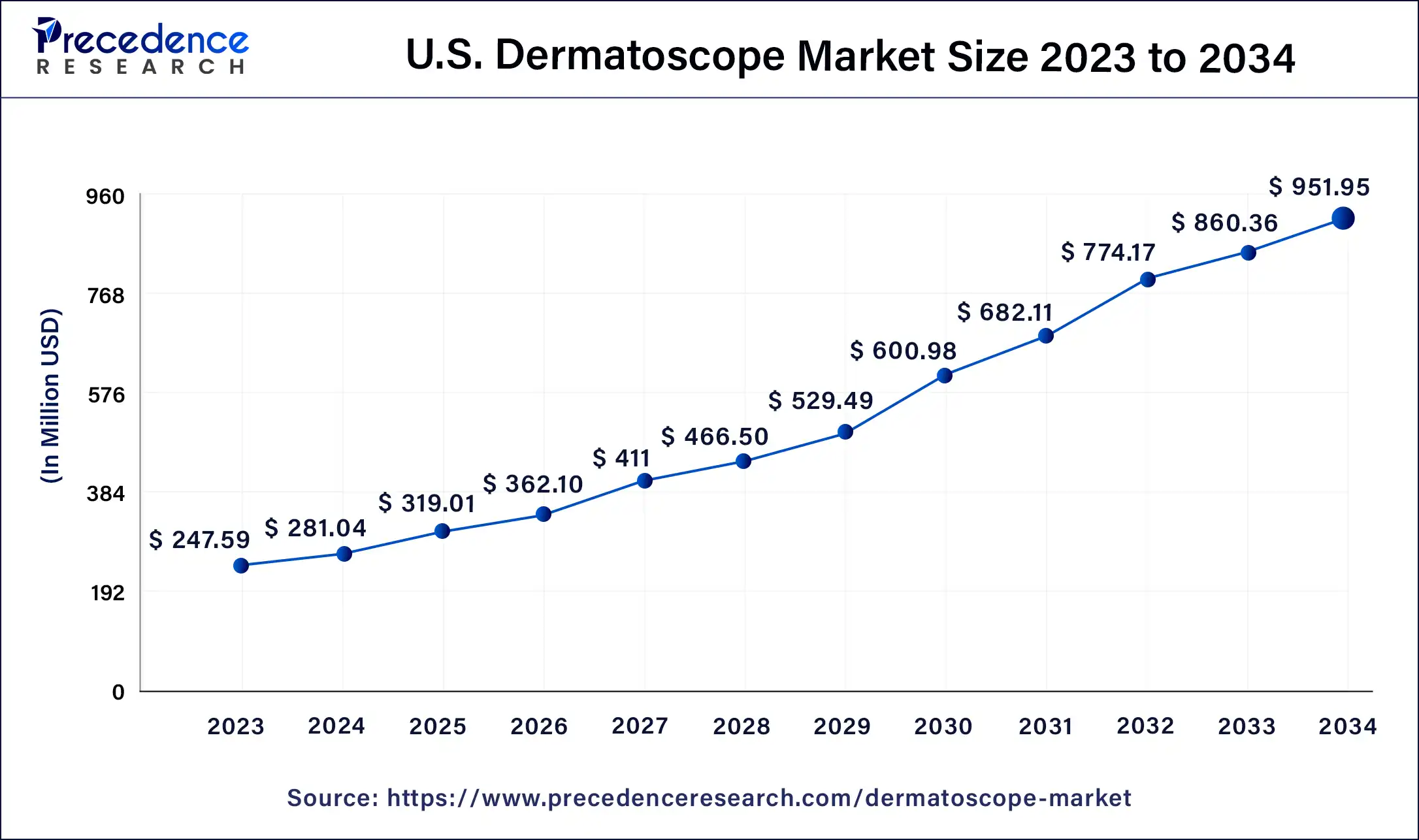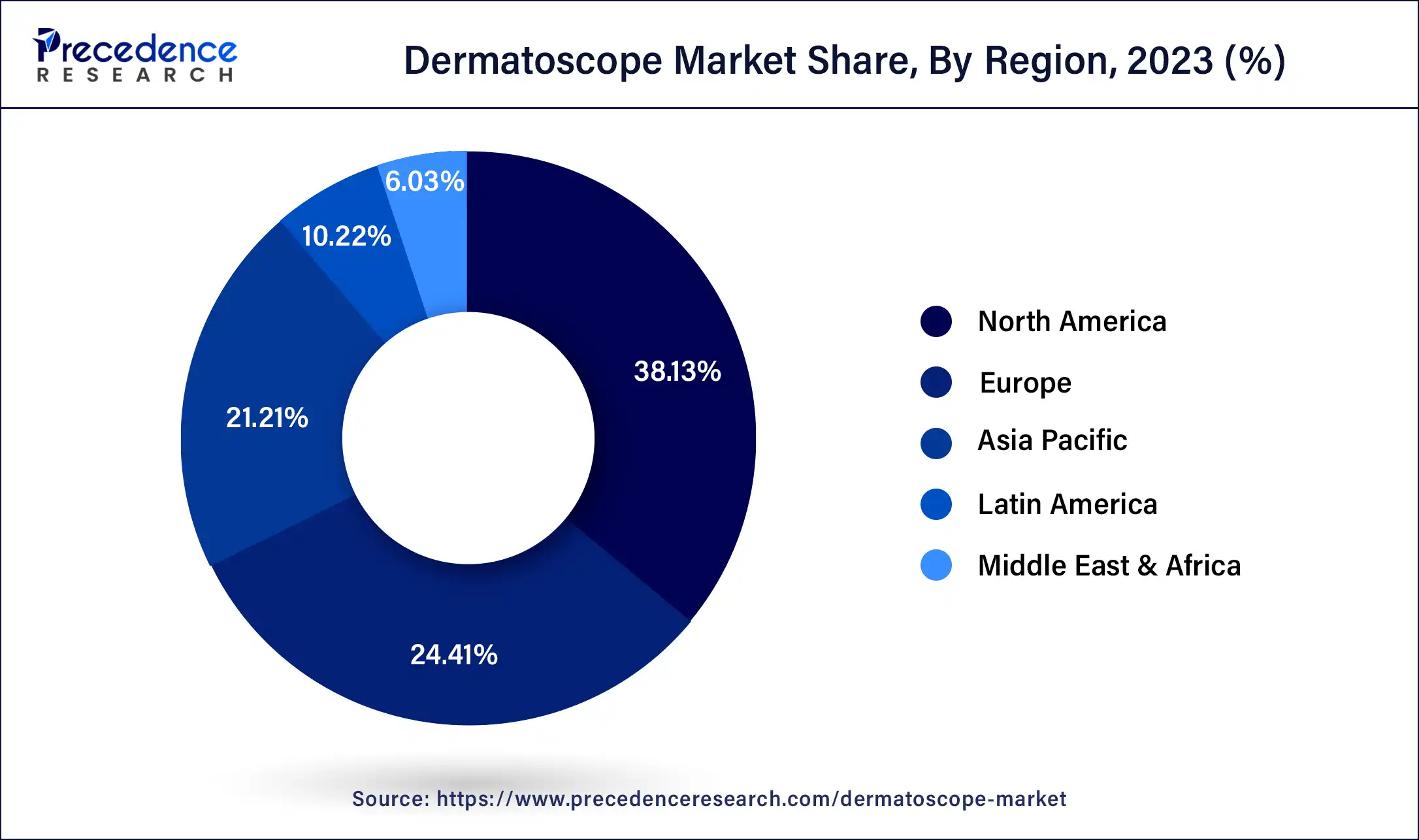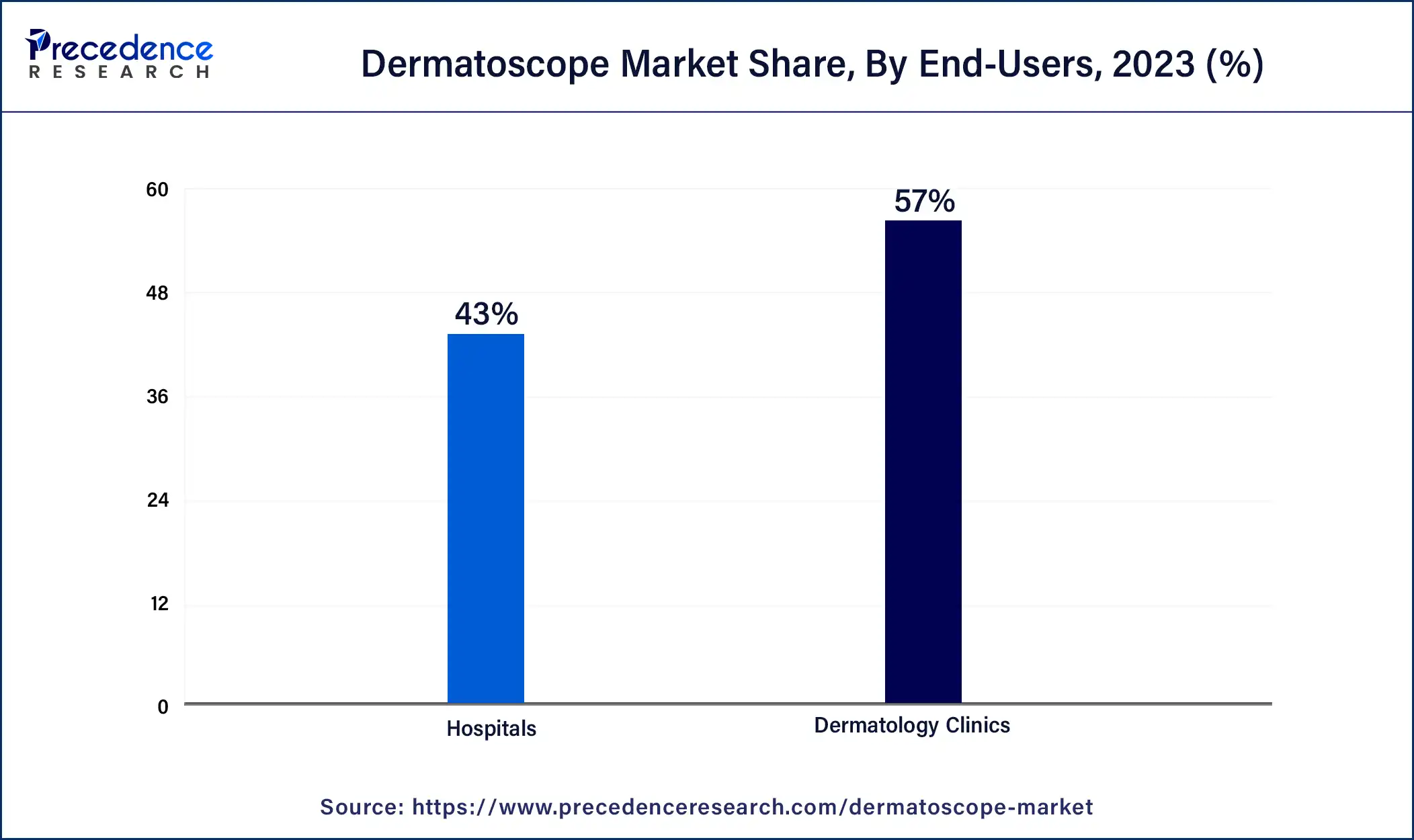Dermatoscope Market (By Product: Contact, Hybrid, Non-contact Dermatoscope; By Technology: LED, Xenon, Halogen, Ultraviolet; By Method: Handheld, Trolly Mounted, Headband; By Application: Skin Cancer, Scabies, Warts, Fungal Infection, Others; By End-User: Hospitals, Dermatology Clinics) - Global Industry Analysis, Size, Share, Growth, Trends, Regional Outlook, and Forecast 2024-2034
The global dermatoscope market size was USD 925.94 million in 2023, accounted for USD 1,045.58 million in 2024, and is expected to reach around USD 3,364.21 million by 2034, expanding at a CAGR of 12.4% from 2024 to 2034. The North America dermatoscope market size reached USD 353.01 million in 2023. Rising prevalence of skin cancer (melanoma& non-melanoma) to drive the growth of the global dermatoscope market.

The U.S. dermatoscope market size was estimated at USD 247.59 million in 2023 and is predicted to be worth around USD 951.95 million by 2034, at a CAGR of 13% from 2024 to 2034.

Geographically, North America holds the largest revenue share in the dermatoscope market. The presence of technologically advanced healthcare infrastructure is seen as a significant driver for the dermatoscope market in the North American region. The rapid adaptation of technologically advanced devices in the dermatology industry and increasing demand for cosmetic surgeries in recent years have boosted the growth of the dermatoscope market in Europe.
The increasing prevalence of skin diseases such as inflammatory dermatoses, basal cell carcinoma, and actinic keratosis is anticipated to fuel the growth of dermatoscope market in the Asia Pacific region. Increasing demand for cosmetic surgeries and the presence of surging awareness for skin health care has propelled the growth of dermatoscope market in gulf countries (Saudi Arabia, UAE, Kuwait, and Oman), which is likely to show significant change for the market in the Middle East.

Dermatologists use Dermatoscope in dermatoscopy, which includes observing skin lesions to detect skin diseases such as skin cancer (melanoma). Dermatoscope is a device that allows dermatologists to visualize the surface of skin structures that cannot be seen with the naked eye. It also helps examine the nails, scalp, and hair. The dermatoscope device contains a non-polarized light source, a magnifier, and a transparent plate that allows proper skin visualization in detail. Dermatoscope can take pictures of skin which later are examined by dermatologists to diagnose the disease.
The dermatoscopic pictures are photographed and saved for evaluation. Dermatoscope devices are majorly used in hospitals and dermatology clinics. However, advanced dermatoscopes provide visualization for the diagnosis of all types of skin issues; the machines are widely used in the diagnosis of skin cancer and skin tumor. Skin cancer is usually found in the first two layers of the skin, but to discern detailed structures of the skin, dermatoscopes play a vital role in the dermatology sector. Advanced dermatoscopes have helped the dermatology unit to diagnose skin lesions quickly. The utilization of dermatoscopes has improved the accuracy of diagnosis for dermatologists.
Along with this, early dermoscopy has reduced the unnecessary prolonged treatment and removal of benign skin lesions. Dermlite D3N, Heine Delta 20, SkinCeuticalsSkin Scope, and KaweEurolight 30 are a few popular dermatoscopes available in the market that dermatologists highly recommend. Moreover, the advancement of dermatoscopic devices is yet to make the process of dermoscopy more reliable and quicker.
| Report Coverage | Details |
| Market Size in 2023 | USD 925.94 Million |
| Market Size in 2024 | USD 1,045.58 Million |
| Market Size by 2034 | USD 3,364.21 Million |
| Growth Rate from 2024 to 2034 | CAGR of 12.4% |
| Base Year | 2023 |
| Forecast Period | 2024 to 2034 |
| Largest Market | North America |
| Segments Covered | By Product, By Technology, By Method, By Application, and By End-User |
| Regions Covered | North America, Europe, Asia-Pacific, Latin America, and Middle East & Africa |
The dermatoscope market is projected to grow during the forecast period of 2024-2034, owing to the increased utilization of advanced aid devices in the healthcare sector. The utilization of dermatoscope has increased by dermatologists due to their accurate visual inspection of skin structures. Developing healthcare infrastructure in developing countries is anticipated to bring opportunities for investors and developers in the dermatoscope market. The reliability and accountability associated with dermatoscope as compared to any other melanoma detection measure, have fueled the growth of the global dermatoscope market.
The increasing prevalence of skin cancer (melanoma& non-melanoma) is seen as a significant driving factor for the global dermatoscope market in upcoming years. Skin cancer is the fastest-growing cancer type globally, which has gained concern.
The increasing research and development sector to invent advanced dermatoscope, rapidly increasing demand for cosmetic surgeries to change physical appearance, growing awareness about skin issues such as fungal infection, scars, warts, and many other skin diseases and technologically advanced treatment options are a few other factors driving the growth of dermatoscope market. Along with this, partnership, collaboration, and acquisition by prominent key players to enhance or expand their dermatoscope product portfolio are considered a significant driver for the dermatoscope market.
For instance, in the year 2021, a global leader in imaging systems, Canfield Scientific, acquired Medici Medical. The acquisition aims to expand Canfield Scientific's dermoscopy portfolio and begin a new dermatology education program. The rising cost of dermoscopy and the overall cost associated with any skin treatment are seen as major restraining factors for the growth of dermatoscope market. Few medicine imaging alternatives, such as Single Photon Emission Computed Tomography (SPECT) and Positron Emission Technology (PET), have hampered the growth of dermatoscope market. Additionally, the prolonged-time period required for the examination and diagnosis has affected consumer behavior toward dermoscopy which is another restraining factor for the dermatoscope market. However, technologically advanced dermatoscope will overcome this restraint.
Based on product, the dermatoscope market is segmented into contact, hybrid, and non-contact dermatoscope. The contact dermatoscope segment holds the largest revenue share in the dermatoscope market. The availability of wide range of contact dermatoscope devices with polarized light makes the contact dermatoscope a leading component in the market. There are two types of contact dermatoscope. Polarized and non-polarized contact dermatoscopes are used in the process of dermoscopy. According to dermatologists, the polarized contact dermatoscope provides a better visual of deeper skin structures, and whereas the non-polarized contact dermatoscope allows superficial vision.
The hybrid dermatoscope segment is anticipated to grow during the forecast period owing to its benefit of carrying both contact and non-contact dermatoscope qualities. The hybrid dermatoscope is designed with this combination for better imaging purposes. A recent example of a hybrid dermatoscope is Dermlite D200 dermatoscope developed by 3Gen Company. The non-contact dermatoscope possesses the qualities of advanced medical imaging technology as they provide an excellent vision of skin structures in detecting skin cancer. The adoption of non-contact dermatoscopes is seen to increase owing to their advanced efficacy.
The dermatoscope market is segmented based on technology: LED, xenon, halogen, and ultraviolet. LED is the fastest-growing segment in the global dermatoscope market due to its lower heat production quality that prevents accidents during dermoscopy. Halogen bulbs produce comparatively more heat than LED bulbs provided in the dermatoscope, which are likely to affect the skin and cause accidental fatalities. Ultraviolet dermatoscopes provide high-quality resolution imaging after the dermoscopy and thus offer quick results. The segment is anticipated to grow, considering the benefits of ultraviolet technology.
The dermatoscope market is segmented based on method: a handheld, trolley mounted, and Headband. The handheld segment dominated the global dermatoscope market as they are convenient to use. The advanced handheld dermatoscopes are lightweight and thus offer enhanced visualization for dermatologists. With the rapid adoption of handheld dermatoscope devices, the demand for such dermatoscopes is increasing.
Firefly DE300 is a prime example of a handheld dermatoscope available in the global dermatoscope market. The trolley-mounted dermatoscopes allow imaging of the entire skin surface within a few clicks. The cost associated with trolley-mounted dermatoscopes is high, which makes the demand limited. Headband dermatoscopes are worn by dermatologists or experts on their heads to get a proper visual of a patient's skin. The headband segment is anticipated to grow in the upcoming years owing to its portability factor.
The dermatoscope market is segmented based on application into skin tumors, scabies, warts, and fungal infection. The increasing prevalence of skin cancer is anticipated to boost the demand for advanced dermatoscopes in the market during the forecast period, which will grow the skin tumor segment. Dermoscopy is a widely used technique to diagnose skin tumors. Increasing skin cancer patients across the globe are likely to drive the skin tumor segment toward growth. Dermatoscopes are commonly used in diagnosing scabies as it takes less time. The increasing prevalence of fungal infection (skin, hair, or nails) is anticipated to boost the growth of the global dermatoscope market through the fungal infection segment. Other applications of dermatoscope include cosmetic surgeries, hair fall treatments, and evaluation of nails disorder.
Based on end-user, the dermatoscope market is segmented into hospitals, and dermatology clinics. Increasing skin issues, skin cancer, and cosmetic surgeries to enhance physical appearance have increased the number of patients in dermatology clinics.

Special dermatology clinics provide advanced skincare facilities and the availability of advanced technology makes the dermatology clinics a leading segment of the dermatoscope market. Patients with advanced-level skin cancer are advised to visit technologically advanced hospitals (where cancer specialists are available); this factor makes the hospital segment the second largest segment for the dermatoscope market.
Segments covered in the report
By Product
By Technology
By Method
By Application
By End-User
By Geography
For inquiries regarding discounts, bulk purchases, or customization requests, please contact us at sales@precedenceresearch.com
No cookie-cutter, only authentic analysis – take the 1st step to become a Precedence Research client